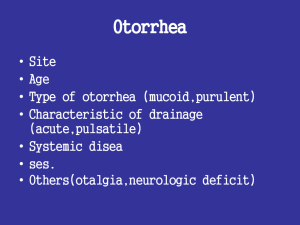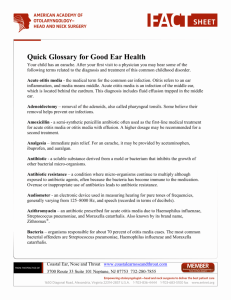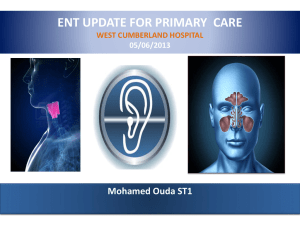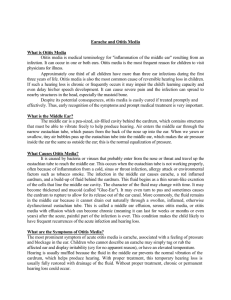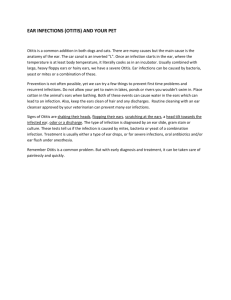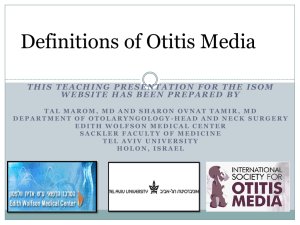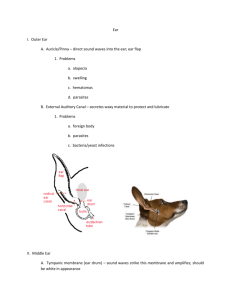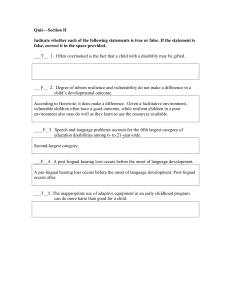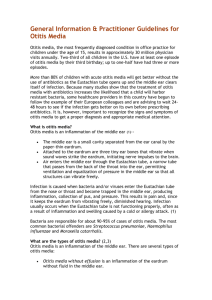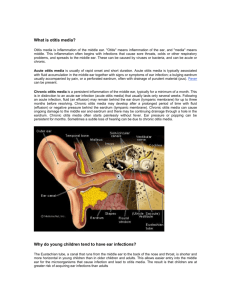What is Otitis media?
advertisement
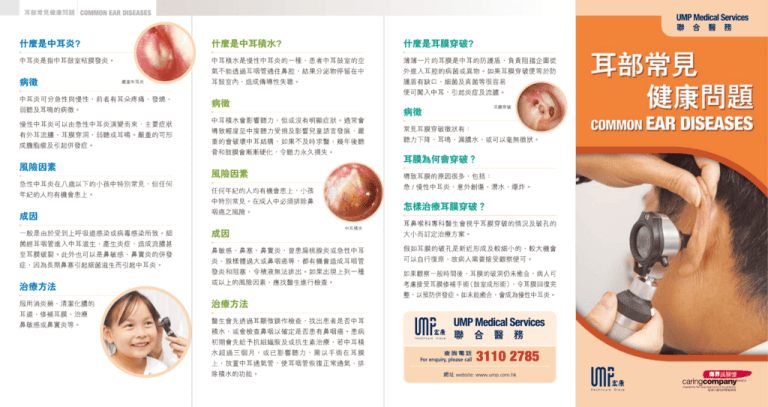
Common ear DiseaseS What is Otitis media? What is Otitis media with effusion (OME)? Otitis media is inflammation of the middle ear, or middle ear infection. Symptoms Acute otitis media Otitis media includes acute otitis media and chronic otitis media. Symptoms Common symptoms of chronic otitis media includes ear purulent discharge, perforated ear-drum, deafness and tinnitus. In serve cases, there may be cholesteatoma and leading to intracranial complications. OME usually affects hearing acuity but it may not be symptomatic. It will cause some patients suffer from low to medium level of hearing loss Otitis media with effusion and cause speech developmental delay in children. In some serve cases, it would damage the structure of middle ear. If untreated, the ear bone and eardrum may become sclerotic which will cause permanent hearing loss. It is a common disease in children aged below 8 but it can affect anyone at any age. Causes Risk Factors This type of infection is caused by upper respiratory tract infection. The bacteria virus propagate in the middle ear through eustachian tube which causes inflammation and even perforation of eardrum. Also, allergic rhinitis or sinusitis is the predisposing factor in otitis media as long-term nasal blockage may cause otitis media. Treatment • Antibiotic • Toileting of the ear • Eliminate predisposing factors like allergic rhinitis or sinusitis • Repair the ear drum The eardrum separates the middle ear and external ear canal. If it is perforated, bacteria or fungus can enter into the middle ear causing inflammation and pus discharge. Otitis media with effusion is one of the diseases of chronic otitis media. The middle ear does not allow ventilation through the eustachian tube to nasal cavity. As a result, the secretion would stay in the middle ear that can cause deafness. The symptoms of acute otitis media includes ear pain, fever, deafness and ringing in the ear. Risk Factors What is Rupture of the Eardrum? Otitis media with effusion can affect anyone at any age. Moreover, it is a common disease in children. Nasopharyngeal carcinoma needs to be excluded in adult patients. Symptoms Causes The causes including allergic rhinitis, nasal congestion, sinusitis, acute otitis media, tonsilladenoid hypertrophy, nasopharyngeal carcinoma and so on. Those diseases would cause the inflammation and blockage of eustachian tube. As a result, the effusion cannot eliminate. While more than one risk factors have been incurred, it is advisable to seek medical advice to conduct an ear check up. Treatment The doctor would use an otoscope to check the ear to diagnose OME. In some cases, hearing tests will need to be done. In the early stage of treatment, antihistamine and/or antibiotic are provided. While the otitis media with effusion lasts for 3 months or it has affected the hearing, operation on eardrum needs to be done. The grommet is implanted on the eardrum that can recover the function of eustachian tube including ventilation and elimination of effusion. Common symptoms are: • Hearing loss • Ringing in the ears • Otorrhoea • It may not be symptomatic Eardrum perforation Causes • Acute / chronic suppurative otitis media • Traumatic accident • Diving • Explosion Normal Eardrum Treatment The doctor would provide an appropriate treatment to the patient depending on different circumstances and the size of perforation of eardrum. While the rupture of eardrum is occurred recently, in general, it may be self-recovered. It is appropriate that the patient is kept under observation. After a certain period of time if the rupture of eardrum has not recovered, the patient could consider to undergo the tympanoplasty to repair the rupture of eardrum. If left untreated or not heal up, it would become chronic suppurative otitis media.
